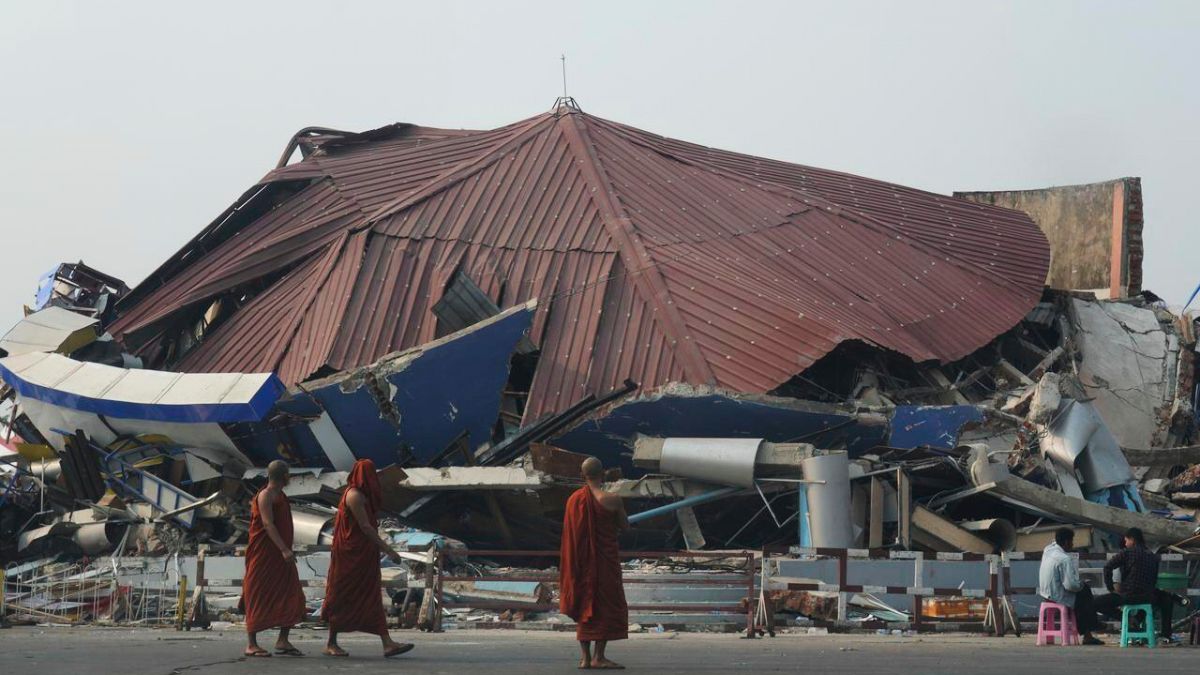The death toll in Myanmar, which was hit by a powerful earthquake on Friday (March 28), has climbed to over 1,000 with more than 2,300 injured, according to the country’s ruling military government. A 7.7 magnitude quake and an aftershock measuring 6.4 jolted the war-torn country and its neighbouring Thailand, resulting in collapsed buildings and infrastructure.
On Saturday (March 29), international aid started to arrive in Myanmar, which has been marred by four years of civil war. India has sent aid packages, along with search-and-rescue and medical teams, to the Asian country.
A 37-strong team from China landed in Yangon, Myanmar’s former capital, today with medicine and equipment to detect signs of life, the Chinese embassy wrote in a post on social media. Russia and the United States have also offered assistance.
Myanmar’s junta chief, Min Aung Hlaing, had warned yesterday that the casualties and injuries from the strong tremors are “expected to rise”, after announcing at least 144 people were killed and 730 others were injured.
But what caused such a big earthquake in Myanmar? Why are more casualties feared? We will explain.
Why do earthquakes occur?
Earthquakes take place when massive slabs of solid rock that form Earth’s crust, described as tectonic plates, shift against each other.
As these plates move at different speeds and directions, energy builds up. When this energy is released, it causes the Earth’s surface to shake fiercely known as an earthquake .
If the energy is released beneath an ocean, it leads to several huge waves called a tsunami.
What’s behind Friday’s quake in Myanmar?
Myanmar is prone to earthquakes due to its location between two tectonic plates – the India and Eurasia plates. In fact, it is among the world’s most seismically active countries. The boundary between these tectonic plates is known as the Saigang Fault.
According to experts, the Saigang Fault is a long, straight line that runs about 1,200 km from north to south along cities such as Mandalay and Yangon, reported Al Jazeera.
“The plate boundary between the India Plate and Eurasia Plate runs approximately north-south, cutting through the middle of the country,” Joanna Faure Walker, a professor and earthquake expert at University College London, told Reuters.
As per the United States Geological Survey (USGS), the Myanmar quake happened due to “strike-slip faulting” between the India and Eurasia plates. This means these two tectonic plates rubbed sideways against each other.
Japan’s Meteorological Agency also confirmed that Friday’s trembler in Myanmar was caused by horizontal slips of land, or “strike-slip” faults, reported NHK WORLD-JAPAN.
Speaking to The Guardian, Bill McGuire, emeritus professor of geophysical and climate hazards at University College London, said, “The quake happened on the Sagaing fault, which marks the tectonic plate boundary between the Indian plate to the west and the Eurasian plate to the east. The Indian plate is moving north along the fault compared to the Eurasian plate.”
Dr Rebecca Bell, a tectonics expert at Imperial College London, compared the Saigang Fault to the San Andreas Fault in California, which caused the 1994 Northridge earthquake that killed 60 people and destroyed 87,000 structures.
“The straight nature means earthquakes can rupture over large areas – and the larger the area of the fault that slips, the larger the earthquake,” she was quoted as saying by the London-based Science Media Centre.
Sagaing has reported several earthquakes in recent years, with a 6.8 magnitude quake hitting in late 2012 that led to 26 deaths and scores of injuries.
ALSO READ: Why did the 4-magnitude earthquake in Delhi feel so strong?
Why fatalities in Myanmar could soar
The epicentre of Friday’s quake was in the Sagaing region, near the Myanmar city of Mandalay.
The tremors have killed 1,002 people, and injured 2,376 others with 30 missing, BBC reported citing Myanmar’s ruling military. Most of these fatalities are reported in the war-hit country’s second-largest city of Mandalay.
The death toll and destruction in Myanmar is likely to rise further.
The USGS says Friday’s quake is believed to have arisen at a shallow depth of just 10 km. “This is very damaging because it has occurred at a shallow depth, so the shockwaves are not dissipated as they go from the focus of the earthquake up to the surface. The buildings received the full force of the shaking,” Dr Roger Musson, honorary research fellow at the British Geological Survey, told Reuters.
The USGS Earthquake Hazards Program has warned that the casualties from Myanmar’s powerful earthquake could be between 10,000 and 100,000 people. It also estimated that the economic losses from the disaster could be as high as 70 per cent of Myanmar’s GDP.
“This is a major quake by any standard, and its impact is made far worse by the fact that it was very shallow – only about 10km down. If it had been 100 km deep, the impact would have been much smaller, so depth as well as size is critical,” McGuire was quoted as saying by The Guardian.
As large seismic events are comparatively rare in the Sagaing region, infrastructure is not expected to be earthquake-resilient. This means the scale of destruction could be much worse.
Musson told the British newspaper that the last major quake in the region was reported in 1956. “This means that buildings are unlikely to be designed against seismic forces, and therefore are more vulnerable when an earthquake like this occurs, resulting in more damage and higher casualties,” he said.
As per the USGS projections, roughly 800,000 people in Myanmar may have been in the areas most affected by the violent tremors and the death toll is likely to surge sharply in the coming days.
Experts say the level of damage in Myanmar could be as high as that caused by the 7.8-magnitude earthquake in Turkey and Syria in 2023. More than 50,000 people had died and entire cities were razed across south-east Turkey by the deadly quake.
With inputs from agencies
)